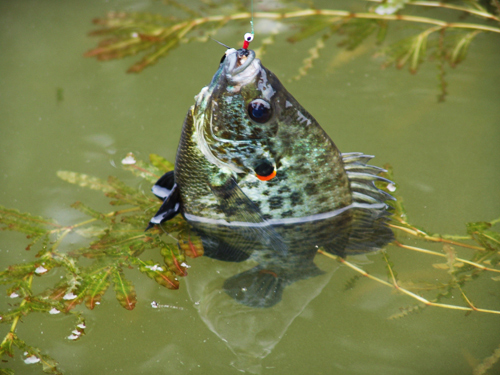BY Lee McClellan
(Editors: This is the seventh installment of the “Spring Fishing Fever” series of fishing articles. Produced by the Kentucky Afield Outdoors staff, the series details productive fishing opportunities across Kentucky. It will continue until early summer).
FRANKFORT, Ky. – It is the time of year when the big “bull” redear sunfish move shallow to spawn, sending a shiver of excitement through the ranks of many Kentucky anglers.

When the big redear sunfish move up to spawn, it produces some of the best fishing of the year. The ability of hefty redear sunfish to use their saucer-shaped bodies to pull against a rod is legendary. If this species grew to 10 pounds, it might be nearly impossible to land one.
March brought record snowfall across Kentucky and April came along with huge rainfall that set some one-day records in central Kentucky. This spring has proven tough for Kentucky anglers.
However, it is Derby time in the Bluegrass with air temperatures approaching 80 degrees by early next week.
A stable weather pattern with warming air temperatures and water temperatures ranging from 65 to 68 degrees make ideal conditions for redear sunfish.
“The last week of April and into the first week of May is pretty consistently the time frame where you see the redear spawning,” said Neal Jackson, fisheries research biologist for the Kentucky Department of Fish and Wildlife Resources.
Water temperatures on Kentucky Lake last weekend exactly matched those parameters, with the main lake at 65 degrees and the flats in the bays at 68 degrees.
Redear sunfish are commonly called “shellcrackers” because they feed on small mussels and snails on the bottom. They have a plate of teeth in their throats that can crush shells.
Kentucky Lake and its twin to the east, Lake Barkley, are head and shoulders above other waters in Kentucky for redear sunfish. These huge reservoirs hold many redears longer than 11 inches, the kind of fish that feels like you are holding a small plate in your hands when you land one.
Pan Bowl Lake in Breathitt County, Clear Creek Lake in Bath County, Fishtrap Lake in Pike County, Elmer Davis Lake in Owen County and Marion County Lake all hold good populations of redear sunfish.
Corinth Lake in Grant County once boasted some of the best redear fishing in Kentucky until an accidental introduction of shad into the lake eventually blunted the fishery. Kentucky Fish and Wildlife eradicated the shad and Corinth Lake is on the way back to its old glory days.
Catching redear is relatively easy, but finding their spawning beds is not. The location of bluegill, who also nest this time of year, indicate where to search for redear sunfish.
“If I was targeting redear and I pulled up on a spot and started catching nice bluegill, it would be hard to leave that scenario,” Jackson said. “But, if you want big redear, I wouldn’t keep fishing that spot. They are in similar places, but the redear are in a little bit deeper water. Move out into 4 to 6 feet of water.”
Jackson recommends staying in a spot once you locate some redear sunfish. “Hit that area hard and stay there for a while,” he said.
A size 6 or 8 Aberdeen-style hook tipped with a quarter inch chunk of red worm or night crawler with a BB-sized split shot about a foot above the hook works great when fished on the bottom for redear. Many anglers tip a small 1/32-ounce yellow or black feather jig, commonly called a Popeye jig, with bits of nightcrawler, wax worms and meal worms and suspend them under a bobber just above bottom.
“You’ve got to have contact with the bottom,” Jackson said. “They are not feeding anyplace but on or near the bottom.”
Ultralight spinning tackle spooled with 4- or 6-pound monofilament line makes great sport for redear. Anglers tend to prefer ultralight rods less than 6 feet long. Those fishing weedy lakes may fare better with 6-foot light power rods and spinning reels spooled with 6- or 8-pound monofilament.
The redear spawn is here. Hit some of these waters and catch a mess for a tasty feast. The flesh of a redear sunfish is as good as any fish in Kentucky waters.
Author Lee McClellan is a nationally award-winning associate editor for Kentucky Afield magazine, the official publication of the Kentucky Department of Fish and Wildlife Resources. He is a life-long hunter and angler, with a passion for smallmouth bass fishing. Get the latest from Lee and the entire Kentucky Afield staff by following them on Twitter: @kyafield.


Be the first to comment